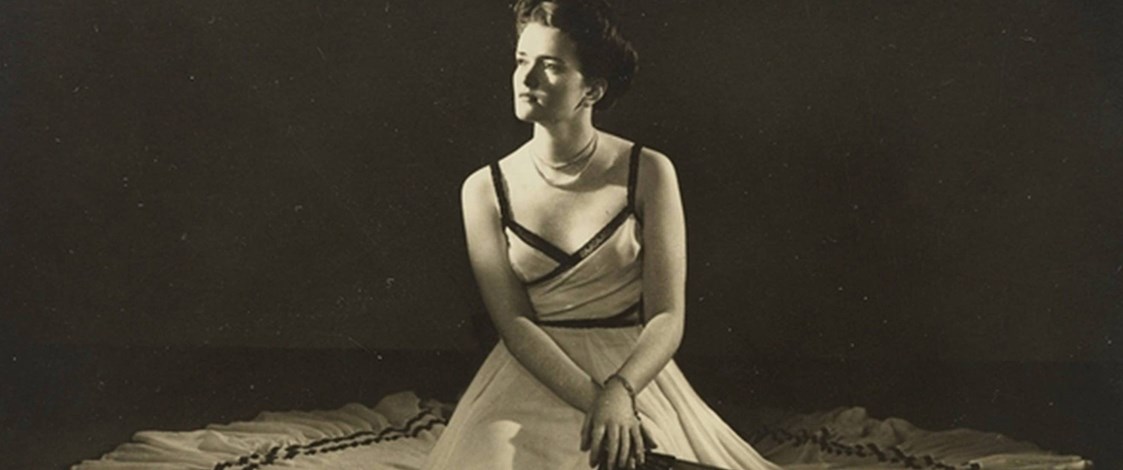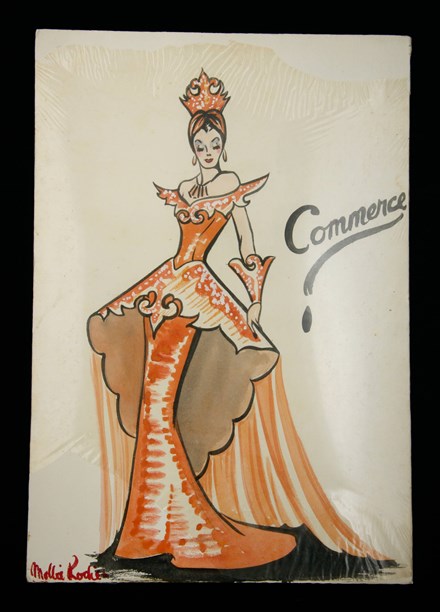Stories
Mollie Rodie
1919-2020

During World War II, New Zealand designer and journalist Mollie Rodie used her fashion talents to patriotic effect. Her splendid costume designs for the Victory Queen Carnival helped raise thousands of pounds for Kiwis fighting overseas and rallied spirits on the home front.
Mollie Rodie was born in 1919 in Invercargill. She trained in art at Wellington Technical College. By just 17, she had travelled to London to study fashion drawing and completed an apprenticeship in fashion design and cutting. When she returned, she worked briefly in Wellington as a trainee designer, and then wrote popular fashion columns and features for several newspapers.
During World War II, Mollie advised women on how to revamp their wardrobes in a period of scarcity. While working full-time, she volunteered for the war effort, designing glamorous costumes for fundraising events. Mollie’s brothers were both serving overseas. She recalls that "every boy I knew was in uniform. It was a grim time for us young people. I wanted to do anything I could to help the war effort."
Her costume designs contributed to the success of grand occasions such as the Centennial Exhibition 'Spirit of Empire' pageant in 1939–40, a Red Cross pageant in 1940, and the Victory Queen Carnival in 1941.
Mollie created several glamorous sketches for the grand finale of the Victory Queen Carnival held in Wellington Town Hall in June 1941. Queen carnivals were a popular way to raise money during World War II. Women dressed in fabulous outfits and competed for votes to raise money for patriotic causes. The winner was crowned Queen of Victory.

Mollie Rodie created this sketch for the grand finale of the Victory Queen Carnival held in Wellington Town Hall in June 1941.
Mollie designed more than 60 costumes and sourced all the fabrics – on top of working full-time. She recalls: "I did a lot of footwork … life was such a scramble!"
The June 1941 event was a triumphant end to a four-month fundraising effort. Hundreds of volunteers helped to raise over £100,000 towards a national appeal to support New Zealand troops, their dependants, and those suffering from bombing in Britain. The fundraising was organised by six queen candidates and their princesses, who were elected and supported by industry, business, and women’s organisations. They used every possible fundraising ploy: garden parties, balls, concerts, competitions, baking – even a burlesque football match. The queen candidate who earned the most votes and money (the public had to pay to cast their votes), was crowned Queen of Victory at the end. Fundraising not beauty won the crown.
Regardless of pomp and glamour, the Carnival was a serious business set against the backdrop of war. The failure of the Battle of Crete in May 1941, the loss of New Zealand servicemen, and subsequent evacuation and imprisonment of New Zealand troops would have weighed heavily on many during this period. Mollie recalls, "There was a great bond between women in those times, many with their men absent, great worries and concerns, not to mention much sorrow and loss". She hoped her glamorous designs would lift people "out of this world of ours".
Mollie married in 1942 and left the dramatic world of pageantry when her Otago sheep farmer husband returned from the war. But she kept working in fashion, continuing a busy freelance career in writing and design. She was also an inveterate collector of twentieth-century fashion and clothing. The Mollie Rodie Mackenzie collection, which was purchased in 1984 by Canterbury Museum, includes over 2,000 items of women’s, men’s and children’s clothing and nearly 800 accessories such as hats, shoes, handbags, gloves, necklaces, scarves, belts and neckties. It also includes fashion-related items such as cosmetics, perfumes, magazines and patterns. The Museum website describes it as " an incredible resource that has been used by students, writers, experts and the curious."
Many of Mollie’s costume sketches were displayed at the Museum of New Zealand Te Papa Tongarewa in 2013 / 2014. They were shown alongside photographs of Wellington women who proudly brought her costumes to life.
Text by Stephanie Gibson. Banner image by S P Andrew, from Museum of New Zealand Te Papa Tongarewa, Wellington, O.039887.
Published August 2013, updated 2024